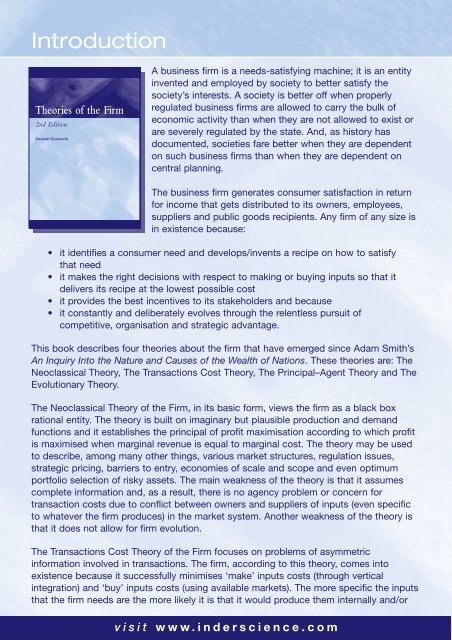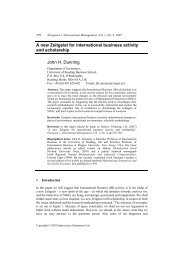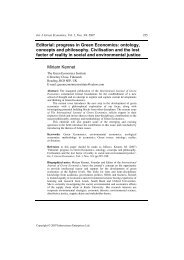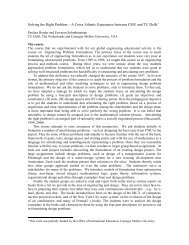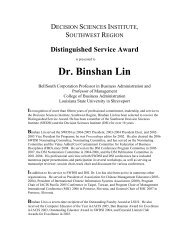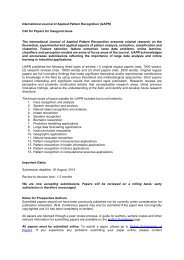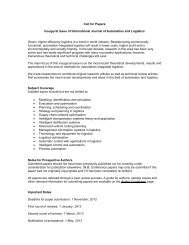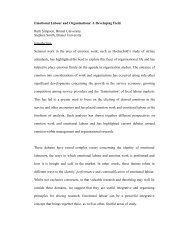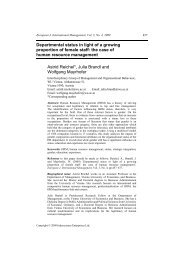Theories of the Firm
Theories of the Firm
Theories of the Firm
You also want an ePaper? Increase the reach of your titles
YUMPU automatically turns print PDFs into web optimized ePapers that Google loves.
Introduction<br />
<strong>Theories</strong> <strong>of</strong> <strong>the</strong> <strong>Firm</strong><br />
2nd Edition<br />
Demetri Kantarelis<br />
A business firm is a needs-satisfying machine; it is an entity<br />
invented and employed by society to better satisfy <strong>the</strong><br />
society’s interests. A society is better <strong>of</strong>f when properly<br />
regulated business firms are allowed to carry <strong>the</strong> bulk <strong>of</strong><br />
economic activity than when <strong>the</strong>y are not allowed to exist or<br />
are severely regulated by <strong>the</strong> state. And, as history has<br />
documented, societies fare better when <strong>the</strong>y are dependent<br />
on such business firms than when <strong>the</strong>y are dependent on<br />
central planning.<br />
The business firm generates consumer satisfaction in return<br />
for income that gets distributed to its owners, employees,<br />
suppliers and public goods recipients. Any firm <strong>of</strong> any size is<br />
in existence because:<br />
• it identifies a consumer need and develops/invents a recipe on how to satisfy<br />
that need<br />
• it makes <strong>the</strong> right decisions with respect to making or buying inputs so that it<br />
delivers its recipe at <strong>the</strong> lowest possible cost<br />
• it provides <strong>the</strong> best incentives to its stakeholders and because<br />
• it constantly and deliberately evolves through <strong>the</strong> relentless pursuit <strong>of</strong><br />
competitive, organisation and strategic advantage.<br />
This book describes four <strong>the</strong>ories about <strong>the</strong> firm that have emerged since Adam Smith’s<br />
An Inquiry Into <strong>the</strong> Nature and Causes <strong>of</strong> <strong>the</strong> Wealth <strong>of</strong> Nations. These <strong>the</strong>ories are: The<br />
Neoclassical Theory, The Transactions Cost Theory, The Principal–Agent Theory and The<br />
Evolutionary Theory.<br />
The Neoclassical Theory <strong>of</strong> <strong>the</strong> <strong>Firm</strong>, in its basic form, views <strong>the</strong> firm as a black box<br />
rational entity. The <strong>the</strong>ory is built on imaginary but plausible production and demand<br />
functions and it establishes <strong>the</strong> principal <strong>of</strong> pr<strong>of</strong>it maximisation according to which pr<strong>of</strong>it<br />
is maximised when marginal revenue is equal to marginal cost. The <strong>the</strong>ory may be used<br />
to describe, among many o<strong>the</strong>r things, various market structures, regulation issues,<br />
strategic pricing, barriers to entry, economies <strong>of</strong> scale and scope and even optimum<br />
portfolio selection <strong>of</strong> risky assets. The main weakness <strong>of</strong> <strong>the</strong> <strong>the</strong>ory is that it assumes<br />
complete information and, as a result, <strong>the</strong>re is no agency problem or concern for<br />
transaction costs due to conflict between owners and suppliers <strong>of</strong> inputs (even specific<br />
to whatever <strong>the</strong> firm produces) in <strong>the</strong> market system. Ano<strong>the</strong>r weakness <strong>of</strong> <strong>the</strong> <strong>the</strong>ory is<br />
that it does not allow for firm evolution.<br />
The Transactions Cost Theory <strong>of</strong> <strong>the</strong> <strong>Firm</strong> focuses on problems <strong>of</strong> asymmetric<br />
information involved in transactions. The firm, according to this <strong>the</strong>ory, comes into<br />
existence because it successfully minimises ‘make’ inputs costs (through vertical<br />
integration) and ‘buy’ inputs costs (using available markets). The more specific <strong>the</strong> inputs<br />
that <strong>the</strong> firm needs are <strong>the</strong> more likely it is that it would produce <strong>the</strong>m internally and/or<br />
visit<br />
www.inderscience.com


